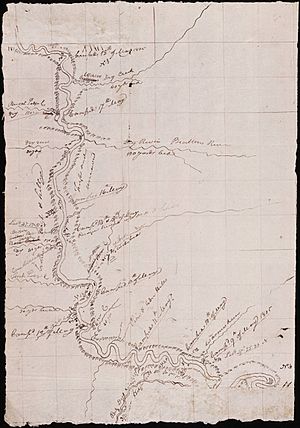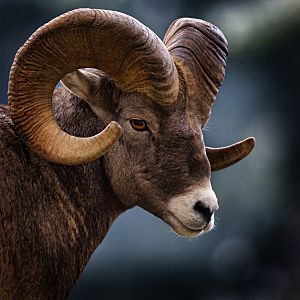Charles M. Russell National Wildlife Refuge facts for kids
Quick facts for kids Charles M. Russell National Wildlife Refuge |
|
|---|---|
|
IUCN Category IV (Habitat/Species Management Area)
|
|
| Location | Montana, USA |
| Nearest city | Billings, MT |
| Area | 915,814 acres (3,706.17 km2) |
| Established | 1936 |
| Visitors | 250000 (in 2010) |
| Governing body | U.S. Fish and Wildlife Service |
| Website | Charles M. Russell National Wildlife Refuge |
The Charles M. Russell National Wildlife Refuge (often called the CMR NWR) is a special place in Montana, USA. It's a National Wildlife Refuge that protects nature and wildlife. This huge area is located along the Missouri River and surrounds the Fort Peck Reservoir.
The refuge is about 915,814 acres (3,706 km2) big. That makes it the second-largest National Wildlife Refuge in the lower 48 states of the U.S. and the biggest in Montana! It was created in 1936. At first, it was called the Fort Peck Game Range. Later, in 1963, it was renamed after Charles M. Russell, a famous Montana artist. He was known for his paintings of the American West. In 1976, its name changed again from a "game range" to a "refuge." This change meant the area would be managed even more strictly to protect its wildlife.
Contents
History of the Refuge
The story of the Charles M. Russell National Wildlife Refuge is closely linked to the building of the Fort Peck Dam. This dam was built on the Missouri River. In the early 1900s, there were big floods on the lower part of the river. People also wanted to develop the upper part of the river. So, the government decided to build large dams. These dams would help stop floods and create electricity. They would also make big lakes for boats.
When the Great Depression started in 1929, many people lost their jobs. Building dams was a way to create jobs. President Franklin D. Roosevelt ordered federal land to be used for the Fort Peck Dam in 1933. More land was added later for the dam project.
Around this time, laws were passed to protect birds. The Migratory Bird Conservation Act (1929) allowed the government to buy land for bird refuges. The Migratory Bird Hunting Stamp Act (1934) created "duck stamps." Hunters had to buy these stamps, and the money helped buy land for refuges.
In 1935, President Roosevelt thought about making a bird refuge around the new Fort Peck Reservoir. A wildlife expert named Olaus Murie studied the area. His report helped convince the government that the area should be a wildlife refuge for all kinds of animals, not just birds.
So, on December 11, 1936, President Roosevelt officially created the Fort Peck Game Range. It was managed to protect wildlife. Over the years, this protected area grew and its name changed. In 1963, it became the Charles M. Russell National Wildlife Range. Later, in 1976, it officially became the Charles M. Russell National Wildlife Refuge. This meant even stronger protection for the animals and their homes.
The refuge is managed by the U.S. Fish and Wildlife Service. This agency works to protect wildlife and their habitats. Part of the refuge, called the UL Bend Wilderness, is a special "wilderness area." This means it's kept as wild as possible, with very few human changes.
Geography and Landscape
Millions of years ago, a huge inland sea covered much of what is now the central United States. This sea was home to many creatures. Dinosaurs like Tyrannosaurus lived in the area around the sea. Because of this, the Charles M. Russell National Wildlife Refuge is rich in fossils of ancient plants and animals.
About 1.5 million years ago, huge sheets of ice called glaciers moved across the land. These glaciers pushed the Missouri River and other rivers into their current paths. The glaciers also scraped away a lot of soil and rock. This is why many fossils are easy to find in the refuge today.
Native Americans often visited this area long ago. They came because many large animals lived near the river. Animals like American bison, mule deer, and Rocky Mountain elk gathered here. The Assiniboine, Gros Ventre, and Piegan Blackfeet tribes hunted in the refuge. The "UL Bend" in the river might be named after a cattle company that grazed its herds there.
The famous Lewis and Clark Expedition explored this area in May 1805. They named many of the features you see in the refuge today. On May 9, they entered what is now the CMR NWR. The explorers faced challenges, like getting sore eyes from the river's water.
They also had exciting encounters with grizzly bears. One time, a bear chased some men down a steep bank into the river! Luckily, they were able to kill the bear. Meriwether Lewis named the creek nearby "Brown Bear Defeated Creek." Today, it's called Snow Creek.
Another important event happened when a sudden storm overturned one of their boats. Many important maps, journals, and tools fell into the river. But Sacagawea, a Native American woman traveling with them, bravely saved almost everything! She calmly stood in the rushing water and pulled the supplies out. The expedition spent two days drying their papers.
The expedition also named Rattlesnake Creek (now Timber Creek) and Burnt Lodge Creek (now Seven Blackfoot Creek). They left the refuge area around May 24, after exploring it for about a week.
Size and Location
The Charles M. Russell National Wildlife Refuge stretches for about 125 miles (201 km) along the Missouri River. It goes from the Fort Peck Dam to the Fred Robinson Bridge. The UL Bend National Wildlife Refuge is next to the western part of the CMR NWF.
The refuge also includes parts of six counties in Montana: Fergus, Phillips, Petroleum, Garfield, Valley, and McCone counties.
Sometimes, people say the refuge is 1.1 million acres (4,500 km2) big. This number usually includes the Fort Peck Reservoir. However, the reservoir is not officially part of the refuge. The refuge itself is about 915,814 acres (3,706 km2).
Animals, Plants, and How the Refuge is Managed
The refuge has four main types of natural areas, called habitats:
- River bottom: The land right along the river.
- Riparian zones and wetlands: Areas with water and special plants that grow near rivers and wet spots.
- Shoreline: The edges of the Fort Peck Reservoir.
- Upland: Higher ground, including forested valleys and open grasslands (prairie).
For many years, the refuge was managed by two different government agencies. But in 1976, a law called the Game Range Act changed this. It gave the U.S. Fish and Wildlife Service (FWS) the main job of managing the refuge. The FWS works to make sure wildlife is the top priority in the refuge.
The Charles M. Russell National Wildlife Refuge is home to many amazing animals. It has the largest group of Rocky Mountain bighorn sheep outside of the Rocky Mountains. You can also find beavers, cougars, coyotes, mule deer, prairie dogs, porcupines, pronghorn, Rocky Mountain elk, and white-tailed deer.
Some animals living here are special because they are threatened or endangered. This means their populations are very low, and they need protection. These include the black-footed ferret, black-tailed prairie dog, burrowing owl, gray wolf, grizzly bear, least tern, mountain plover, northern leopard frog, pallid sturgeon, piping plover, greater sage-grouse, sicklefin chub, and sturgeon chub. The refuge also has a large number of sharp-tailed grouse and about 235 other kinds of birds. It's also home to 4,000 prairie elk, which is the biggest group of prairie elk left in the United States.
Visiting the Refuge
About 250,000 people visit the Charles M. Russell National Wildlife Refuge every year. This makes it one of the most visited national wildlife refuges in the U.S.
The U.S. Fish and Wildlife Service allows people to hunt and fish in certain parts of the refuge. There are many roads, mostly gravel and dirt, that help visitors explore about 80 percent of the refuge. This includes access to 135 miles (217 km) of riverbank and lakeshore.
Fort Peck Interpretive Center
If you want to learn more about the refuge, you can visit the Fort Peck Interpretive Center. It's located in Fort Peck, Montana. This center has an aquarium with local fish and stuffed animals from the area. You can also see casts of dinosaur fossils found nearby.
One of the coolest things to see is a full cast of a Tyrannosaurus rex dinosaur. This T. rex is known as "Devil Rex." It was found in the refuge in 1988! The center also has exhibits about how the Fort Peck Dam was built and the history of the area. You can even take guided tours of the dam's powerhouse. The center opened in 2005 and is a partnership between the U.S. Army Corps of Engineers and the U.S. Fish & Wildlife Service. It's also part of the Montana Dinosaur Trail.
Amazing Fossil Discoveries
The Charles M. Russell National Wildlife Refuge is a very important place for finding dinosaur fossils.
In 1988, the "Devil Rex" (MOR 555) Tyrannosaurus rex was found here. This fossil was about 46 percent complete. It was special because it included the first complete T. rex forelimb (arm) ever found! Scientists even found tiny traces of blood components inside some of its bones. This fossil is now a main attraction at the National Museum of Natural History in Washington, D.C.
Another Tyrannosaurus rex fossil, called "B-Rex" (MOR 1125), was found in the refuge in 2000. Scientists found preserved soft tissue in its leg bone! This tissue was found to be collagen, a type of protein. This was a huge discovery because soft tissue usually doesn't last for 70 million years.
In 2010, a hunter found an elasmosaur fossil in a canyon in the refuge. Elasmosaurs were long-necked marine reptiles that lived in the ancient sea. This fossil turned out to be a new species of short-necked elasmosaur. It was named Nakonanectes bradti after the hunter who found it.
Images for kids







